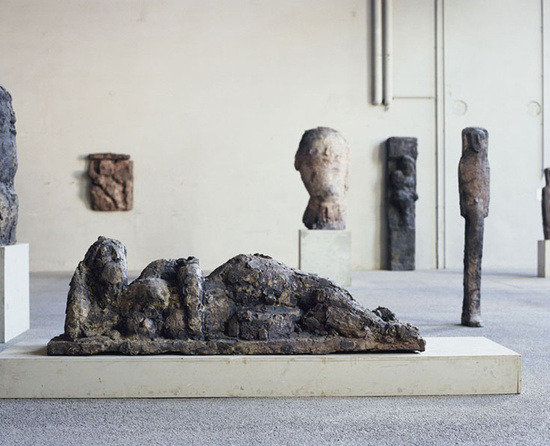Hans Josephsohn
dal 14/1/2014 al 21/2/2014
Segnalato da
14/1/2014
Hans Josephsohn
Hauser & Wirth New York, New York
Josephsohn. The German-born Swiss artist devoted his practice to the enduring theme of the human figure, which he explored in standing, sitting, and reclining figures, as well as half-figures, heads, torsos, and reliefs.

New York, NY... Beginning 15 January, Hauser & Wirth will present its first New York exhibition devoted to the late sculptor Hans Josephsohn (1920 – 2012). For over six decades, the German-born Swiss artist devoted his practice to the enduring theme of the human figure, which he explored in standing, sitting, and reclining figures, as well as half-figures, heads, torsos, and reliefs. Josephsohn's highly personal artistic language – the distinctive weight, mass, and force he achieved through a bold, immediate, and highly physical way of working – conveys deep understanding of both classical sculpture and Modernist principles. From slim abstracted forms reminiscent of ancient steles, to rough-hewn figures cast in bronze and left unpainted, the artist's output reveals a continuous search to reinvent and express the fundamental humanity of the individual and to summon the presence of a person.
'Josephsohn' will remain on view at Hauser & Wirth East 69th Street gallery through 22 February 2014 and will include works dating from the 1950s until the artist's death in 2012.
Throughout his entire career, Josephsohn explored the formation and reduction of the body as a gradual and continuous process that evolves and develops. Adding and subtracting layer upon layer of plaster, the artist built his figures slowly. With his bare hands, Josephsohn slathered and spread the malleable material onto his casts. Then, employing the aid of a chisel or hammer, he would knock away fragments to create form. Adding small pieces, repairing work, and cutting away at the jaggedness of hard lumps, Josephsohn played with the diverse richness and possibilities that various parts of the body offered.
An important example of Josephsohn's earliest standing figures is 'Untitled' (1951). Slender, yet solid, the pared down form merely hints at her limbs: arms tight to the body, whilst the feet do not surpass the width of the shoulders. Rendered simply and in frontally oriented symmetry, this figure calls to mind ancient Etruscan sculpture. Having established the body as a geometric block, Josephsohn developed a new way of looking and articulating the figure a decade later, as reflected in the voluminous 'Untitled (Ruth)' (1968). In stark contrast to Giacometti, to whom Josephsohn is most often compared, sculptures such as 'Ruth' embody weightiness and the robust materiality of the human body – here with legs like columns, firmly planted to the ground. Yet, by drawing attention to her large breasts, narrowly defined waist, and broad accentuated hips, Josephsohn emphasizes the femininity, vulnerability, and individuality of his model.
Josephsohn's reliefs, in contrast to his freestanding sculpture, were never derived from the physical presence of a model, but as expressions from the artist's imagination, always accompanied by a drawing or sketch. As in his early sculptures, the low reliefs from this period are void of figural representation, rather depicting compositions consisting of abstracted figures and geometric shapes, exemplified in 'Untitled' (1952). Exhibited alongside these early works are Josephsohn's 'high' reliefs from the 1970s and 1990s, which reflect the artist's admiration for Romanesque art. In 'Untitled' (1974), the figures once strictly constrained within the composition attain a new vitality and spontaneity, as if bursting into space and toward the viewer. In the late relief, 'Untitled' (1998), Josephsohn reverts back to the simplification of forms, this time heightening its plasticity further. By incorporating architectural elements into many of his 'high' reliefs, Josephsohn suggests that the relief could belong to a fragment of a large (ancient) sculptural frieze.
In the 1980s, the artist began working on the extraordinary half-figures, which resemble monumental tectonic forms. Like 'Untitled' (1985), Josephsohn's half-figures began as smaller works, comprised of two distinctive parts, which steadily increased in scale over the years and explore the recurring questions of proportion and volume. The head was subsequently transformed into a powerful mass, as in 'Untitled (Verena)' (1986), perhaps inspired by the model's freely falling hair. Then upon reconstructing elements of the face, Josephsohn's process of creation developed as an intense study of the rich variety of bodily means. Time and time again, as exemplified in 'Untitled' (1993), the artist built and removed fragments of plaster, traces which still remain visible and enliven the corporeality and astonishing fragility of the human figure.
During the last decade of his life, Josephsohn's work began to concern itself with the heaviness and mass of the human form. Articulated in the late reclining figure, 'Untitled' (2006), the rough surface possess its own unique beauty, derived from the application and profuse build up of material. More than ever, Josephsohn turned his attention to the expression of the pose, developing a closer relationship to his model, and creating, in what might be his most abstracted phase, the essence of human existence. Reflected in the words of art historian Gerhard Mack, 'To Hans Josephsohn human beings are bodies; everything is expressed in this body – thoughts and feelings, desires and anxieties, stories and expectations. There is nothing beyond this tangible human body and, most of all, there is no truth outside of it.' In generating an oeuvre indicative to an isolated development of form, the artist's work points to a highly focused endeavor to uncover the bare essential of the very person sitting across from him.
Opening Reception: Wednesday 15 January, 6-8 PM
Hauser & Wirth
32 East 69th Street, New York
Hours: Tuesday – Saturday, 10 am – 6 pm
Admission free



